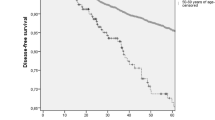Abstract
Background
The objective of this study was to show differences between breast cancer patients ≤35 and >35 years with regard to tumor characteristics and to present the patient-relevant outcomes overall survival (OAS) and recurrence-free survival (RFS).
Methods
We analyzed data from 119 women aged 35 years or younger with breast cancer and compared multiple parameters against breast cancer patients between 36 and 55 (n = 1,097), all pre-menopausal. Data were adjusted for tumor characteristics and therapy.
Results
There was no statistically significant difference in tumor size, axillary lymph node involvement, and histological subtypes. On the contrary, grading lymphovascular invasion and receptor negativity showed statistically significant differences. Unadjusted hazard ratio are 2.11 (1.32–3.39) (OAS) and 1.92 (1.35–2.73) (RFS). Multi-adjusted hazard ratio are 2.97 (1.70–5.18) (OAS) and 2.11 (1.42–3.13) (RFS).
Conclusions
In conclusion, young breast cancer patients still have a poor prognosis. Even after adjustment of the data, OAS and RFS showed a worse prognosis. Normal prognostic factors like tumor size, axillary lymph node involvement, and grading can therefore be not the explanation for the more aggressive disease progress within early onset breast cancer patients.
Similar content being viewed by others
References
Moller P, Evans DG, Reis MM et al (2007) Surveillance for familial breast cancer: differences in outcome according to BRCA mutation status. Int J Cancer 121:1017–1020
Rennert G, Bisland-Naggan S, Barnett-Griness O et al (2007) Clinical outcomes of breast cancer in carriers of BRCA1 and BRCA2 mutations. N Engl J Med 357:115–123
Kim SH, Simkovich-Heerdt A, Tran KN et al (1998) Women 35 years of age or younger have higher locoregional relapse rates after undergoing breast conservation therapy. J Am Coll Surg 187:1–8
Pritchard KI (2007) Adjuvant therapy of the very young woman. Breast 16(Suppl 2):S136–S146
Chung M, Chang HR, Bland KI, Wanebo HJ (1996) Younger women with breast carcinoma have a poorer prognosis than older women. Cancer 77:97–103
Bowen RL, Duffy SW, Ryan DA et al (2008) Early onset of breast cancer in a group of British black women. Br J Cancer 98:277–281
Kim JK, Kwak BS, Lee JS et al (2007) Do very young Korean breast cancer patients have worse outcomes? Ann Surg Oncol 14:3385–3391
Figueiredo JC, Ennis M, Knight JA et al (2007) Influence of young age at diagnosis and family history of breast or ovarian cancer on breast cancer outcomes in a population-based cohort study. Breast Cancer Res Treat 105:69–80
Aryandono T, Harijadi, Soeripto (2006) Breast cancer in young women: prognostic factors and clinicopathological features. Asian Pac J Cancer Prev 7:451–454
Vachon CM, van Gils CH, Sellers TA et al (2007) Mammographic density, breast cancer risk and risk prediction. Breast Cancer Res 9:217
Kuhl CK, Schrading S, Leutner CC et al (2005) Mammography, breast ultrasound, and magnetic resonance imaging for surveillance of women at high familial risk for breast cancer. J Clin Oncol 23:8469–8476
Arndt V, Stürmer T, Stegmaier C et al (2002) Patient delay and stage of diagnosis among breast cancer patients in Germany—a population based study. Br J Cancer 86:1034–1040
Ihemelandu CU, Leffall LD, Dewitty RL et al (2007) Molecular breast cancer subtypes in premenopausal and postmenopausal African-American women: age-specific prevalence and survival. J Surg Res 143:109–118
Kreienberg R for the German Cancer Society. Interdisziplinäre S 3-Leitlinie für die Diagnostik und Therapie des Mammakarzinoms der Frau. Zuckerschwedt. 2004
Kriege M, Brekelmans CT, Boetes C et al (2004) Efficacy of MRI and mammography for breast-cancer screening in women with a familial or genetic predisposition. N Engl J Med 351:427–437
Bartelink H, Horiot JC, Poortmans PM et al (2007) Impact of a higher radiation dose on local control and survival in breast-conserving therapy of early breast cancer: 10-year results of the randomized boost versus no boost EORTC 22881–10882 trial. J Clin Oncol 25:3259–3265
Conflict of interest statement
None.
Author information
Authors and Affiliations
Corresponding author
Additional information
D. Varga and A. Woeckel contributed equally to this work.
Rights and permissions
About this article
Cite this article
Varga, D., Koenig, J., Kuhr, K. et al. Comparison of early onset breast cancer patients to older premenopausal breast cancer patients. Arch Gynecol Obstet 282, 427–432 (2010). https://doi.org/10.1007/s00404-009-1339-y
Received:
Accepted:
Published:
Issue Date:
DOI: https://doi.org/10.1007/s00404-009-1339-y




